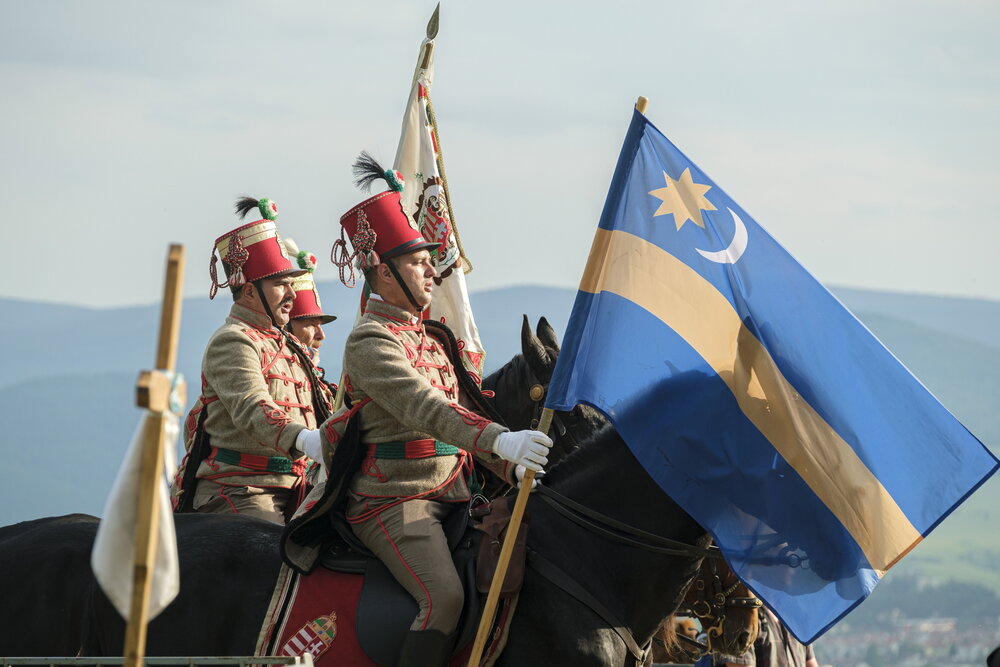Why do hundreds of thousands of Hungarians go to Csíksomlyó on Pentecost?
Every year, hundreds of thousands of people gather in Csíksomlyó (Şumuleu Ciuc) in Transylvania. But what is the reason for that? Read our article to learn about the history and significance of the pilgrimage (búcsú) in Csíksomlyó.
Why do so many people pilgrimage to Csíksomlyó?

Csíksomlyó, 4 June 2022. Source: MTI/Veres Nándor
To this day, the Pentecost Pilgrimage to Csíksomlyó is one of the most important religious events in the history of all Hungarians. Every year, on Pentecost, Hungarian Catholic and Christian believers pilgrimage to Csíksomlyó, Transylvania, in the presence of hundreds of thousands of participants.
According to the faithful, the followers of the Roman Catholic Church can receive a full absolution at Csíksomlyó.
The believer who confesses their sins and repents, visits the shrine in the graceful state of the sacrament of confession and listens to the Holy Mass there, receives a full remission of the punishments remaining after the forgiveness of all their sins.
- Read also: 5 new places in Budapest you should not miss
History

György Udvardy, Archbishop of Veszprém, solemn speaker at the Holy Mass in Csíksomlyó, 4 June 2022.
Source: MTI/Veres Nándor
According to karpateuropa.hu, the Church and Monastery of St. Mary in Csíksomlyó is one of the greatest pilgrimage sites and cultural and historical monuments of Hungarians. The most valuable part of the church is the statue of the Virgin Mary with the baby Jesus.
Its history dates back to 1444, when Pope Eugene IV sent a circular letter to the faithful urging them to help the Franciscan order build a church.

Csíksomlyó. Photo: MTI/Nándor Veres
In return for their help, he allowed them to hold a pilgrimage (búcsú).
The Pope also mentioned in the letter that large crowds of faithful used to gather for devotions and to venerate Mary. The Szekler people’s veneration of Mary goes back a long way, the ‘Lady dressed in the Sun’ being the main patroness of the people and the object of their prayers since the advent of Christianity.
Csíksomlyó and the Pilgrimage since Trianon

Participants of the Pentecost horse pilgrimage in the mountain range of Csíksomlyó on 3 June 2022. Source: MTI/Veres Nándor
Csíksomlyó became a true place of pilgrimage after the Peace Treaty of Trianon. From that time on, the statue symbolized not only the faith in God, but also the survival and the unity of Hungarians in the Carpathian Basin.

June 3 2022 – train departing to Csíksomlyó. Photo:
MTI/Zoltán Balogh
In 2022, on 4 June, the Saturday before Pentecost Sunday, the Pilgrimage to Csíksomlyó was held, which this year coincided with the Day of National Unity.
4 June marked the 102nd anniversary of the signing of the Peace Treaty of Trianon, which resulted in Hungary losing two-thirds of its territory, and some 3.3 million Hungarians stuck outside the borders of the new Hungarian state.
Motto

Source: MTI/Veres Nándor
Every year, the pilgrimage has a motto. The 2005 pilgrimage motto was “Stay with us, Lord!”, the motto of the pilgrimage of 2010 was “Help us now, Mary”, and this year’s was
“Pax et bonum: Peace and goodness!”.

Read alsoHungary lost 2/3rd of its territory 102 years ago: was it inevitable?
Source: karpateuropa.hu, Wikipedia, mandiner.hu, vasarnap.hu, hirado.hu
please make a donation here
Hot news
ESG law strengthens the competitiveness of Hungarian businesses
SHOCKING: Hungary’s guest worker numbers exposed!
According to Minister Navracsics, this one policy will be priority of Hungarian presidency – UPDATED
Today only: Hungarian airline Wizz Air is offering cheap flights!
Budapest Airport wins best airport in the region award for the 11th time!
Amazing: Budapest’s immensely popular Danube beach free this summer!





2 Comments
My Hungarian is lacking, but I was sure that a pilgrimage was a “zarándoklat”, and that a “búcsú” was a (church) fair. Have I been wrong all this time?
Dear Reader, the word ‘pilgrimage’ does mean ‘zarándoklat’ in Hungarian but this is the word they use on every site when referring to the traditional Pentecost event in Csíksomlyó.